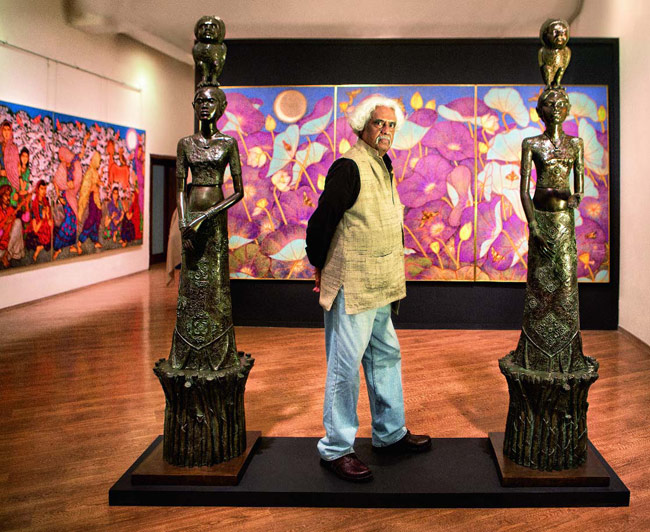Attingal Ramachandran
This is a collection of articles archived for the excellence of their content. |
A profile
Malayali master A.Ramachandran invokes the drama of Sanskrit poetics in present day rural idyll
S. Kalidas
Attingal Ramachandran is one of India's most venerable and versatile artists and is still going strong. Over six-feet tall with his curling mane of white hair and drooping handlebar moustache, he strides the Indian art scene like a dark outsider, not unlike some latter-day Othello, in the otherwise cosy modernist milieu of his times. A loner by temperament, Ramachandran has stayed aloof from the hurly-burly of the scene, preferring to teach at the Jamia Millia Islamia University and practise his art on his own terms. "Nor am I bothered whether or not my work fits into any global trend," he asserts, referring to his rejection of the all-pervading influence of the école de Paris on his art. Nor can he be comfortably grouped with the students of the so-called Bengal School, although he did study at Santiniketan through the late 1950s and early '60s.
Over the last three decades or so, Ramachandran's art has been a fantasy celebration of rural Indian life as it obtains at its most joyous and festive moments. It is a panorama of idealised grace, colour and beauty found in valorous men, melancholy bards, dancing belles, mythical creatures, lotus ponds, fireflies, birds, frogs and bees-all pulsating with the myriad rhythms of life. Sort of Rousseauesque if one were to look for European resonances, but completely Indian in essence, style and manner; maybe even a Raja Ravi Varma stood on his head. Ramachandran has created a visual language that is drawn from traditional Kerala temple murals, Indian miniatures and Sanskrit poetics. A student of classical music and Malayalam literature before he joined the Kala Bhavana at Santiniketan, his aesthetic resources perhaps lie in the magical realm of kathakali and kutiyattam performances. His love for lavish ornamentation, his bold, fantastical, often contrasting colours, could well stem from the simile-encrusted vocabulary of a Kalidasa or a Bhasa. His works employ the devices that are similar to the ones that a kathakali master would use while performing abhinaya to a classical verse.
To mark his contribution to Indian art, the Lalit Kala Akademi and the Vadehra Art Gallery recently showed his works (oils, bronzes, ink drawings, watercolours) at an extraordinarily well-mounted exhibition enigmatically titled 'Ekalinji Fantasy'. Besides his latest paintings and sculptures idolising the rural idyll around the eighth century Eklinji temple near Udaipur in Rajasthan, the exhibition also, significantly, comprised a retrospective of Ramachandran's drawings and sketches spanning well over half a century. Impeccably designed and curated by the celebrated exhibition and museum designer Ronesh Ray, the exhibition accompanied the release of a profusely illustrated two-volume book: A Ramachandran: Life and Art in Lines, edited by the well-known Santiniketan art historian R. Sivakumar.
Rural folk,nature and fantasy sustain Ramachandran's oeuvre'Ekalinji Fantasy' depicts the lush green environs of lotus ponds, birds, insects, rural men and women in their colourful splendour in huge muralsized paintings. The other part of the exhibition consisted of drawings and sketches that were done to realise the larger oil works or his iconic bronze sculptures. "He is very particular about details such as getting the exactly right patina on his bronzes and works hard at it," says the curator remarking about the life-sized bronze sculptures that complement the paintings.
That Ramachandran did a lot of drawing has been evident in his previous shows also, but here we had his whole oeuvre on display. "I must credit his artist wife Chameli for having kept his drawings and sketches so well over all these decades," says Ray, adding, "There were 5,000 drawings to choose from, I could show less than 10 per cent." Ramachandran is married to Chameli, the Santiniketan-born daughter of Professor Tan Yun-Shan, the founder-director of the Institute of Chinese Studies at the Visva-Bharati. She was given the name Chameli by Rabindranath Tagore himself.
Ramachandran's drawings and watercolours depicting people and nature (especially plants and flowers) testify to the veteran artist's amazing command over both his hand and his eye even at this age. His most recent flower studies dated 2014, for example, are amazing in their technical perfection. "I always had a very good visual memory," says Ramachandran, adding, "the first instruction my teacher Ram Kinkar Baij gave me was to go out and draw from nature. It became an addiction. I carry a sketch book and a pen with me constantly." Thus these works cover vastly differing locales from his early days in Attingal in Kerala (1958) to Santiniketan in Bengal where he studied art (1958-1964), then Delhi, and Rajasthan, which he visits regularly. He uses pen and ink, pencil and watercolour in varying combinations on paper. "Just as a blind man comprehends his world through touch, I comprehend my world through drawing," says the artist.
In Santiniketan, his peers and mentors such as Nandalal Bose and Benode Behari Mukherjee also did many nature studies but Ramachandran eschews the wash technique and is far more bold and definitive in his strong flowing lines than one would expect to see from a typical Bengal School brush. However, the exhibition was not a pictorial autobiography. It was not his personal account of a life lived in art. For that, we would have to turn to his immensely illuminating and well-written autobiographical narrative titled 'Life Linedrawings' in the first volume of the book Life and Art in Lines.
